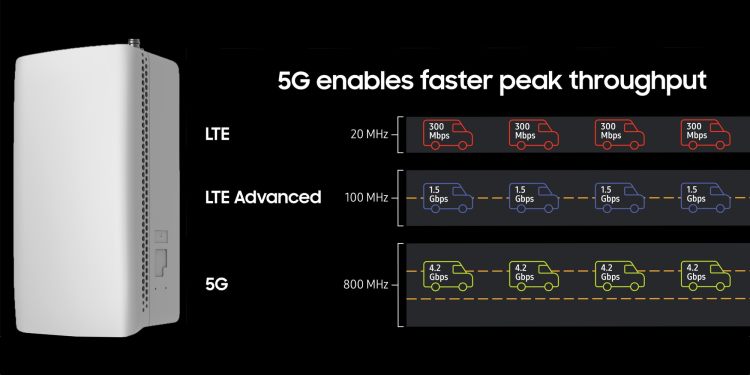Most 5G networks currently use the same low and mid band radio frequencies that were common in the 4G era, but going forward, high band millimeter wave (mmWave) radios promise to deliver much faster speeds — assuming carriers deploy the thousands of “small cells” required to cover large areas with the short-distance radio signals. Today, Samsung is quantifying 5G mmWave’s incredible performance with the results of a new test: A small cell delivered a whopping 8.5Gbps throughput, comparable to fiber cable speeds.
While Samsung’s result comes with caveats, foremost that the 8.5Gbps number was split across two devices that each peaked at roughly 4.3Gbps, the key is that a single 5G mmWave small cell will let carriers transfer vast quantities of data to multiple client devices at once. To achieve the new throughput milestone, Samsung used the 28GHz-capable 5G NR Radio Access Unit announced at MWC Los Angeles in October, with a 1,024-antenna MU-MIMO system and 800MHz of mmWave spectrum.
The 8.5Gbps number is good news for carriers, enterprises, and consumers, as it heralds an age where relatively compact cellular radios will provide ultra-high speed wireless service in urban environments and business campuses — potentially including private corporate 5G networks. Some carriers also plan to use mmWave in large gathering places, such as sports stadiums and concert venues, splitting high-bandwidth connections across hundreds of people.
Major U.S. carriers are all in the process of bulking up their mmWave spectrum holdings to take advantage of 5G small cells. Verizon is already using 400MHz of spectrum in some markets to deliver real-world speeds of up to 1.5Gbps to early 5G smartphone and home broadband users. AT&T and T-Mobile have been less aggressive than Verizon in deploying consumer mmWave services, but all three carriers expect to use mmWave in highly dense settings.
June 5th: The AI Audit in NYC
Join us next week in NYC to engage with top executive leaders, delving into strategies for auditing AI models to ensure fairness, optimal performance, and ethical compliance across diverse organizations. Secure your attendance for this exclusive invite-only event.
Absent mmWave small cells, 5G carriers rely upon low and mid band frequencies, the same general ranges used by 4G devices and Wi-Fi routers, where real-world peak speeds tend to be in the sub-300Mbps to sub-1Gbps range. Engineers have long maintained that the biggest speed gains will come from mmWave radios, specifically because they can rely upon large chunks of radio spectrum that were previously considered unusable due to their one mile or shorter typical transmission ranges.
Samsung has already sold over 6.7 million 5G phones, and is generally considered to be the world’s leader in consumer 5G devices. Its 5G networking hardware is being used by some carriers in South Korea, the United States, and Japan, alongside competing offerings from Ericsson, Nokia, and Huawei.

